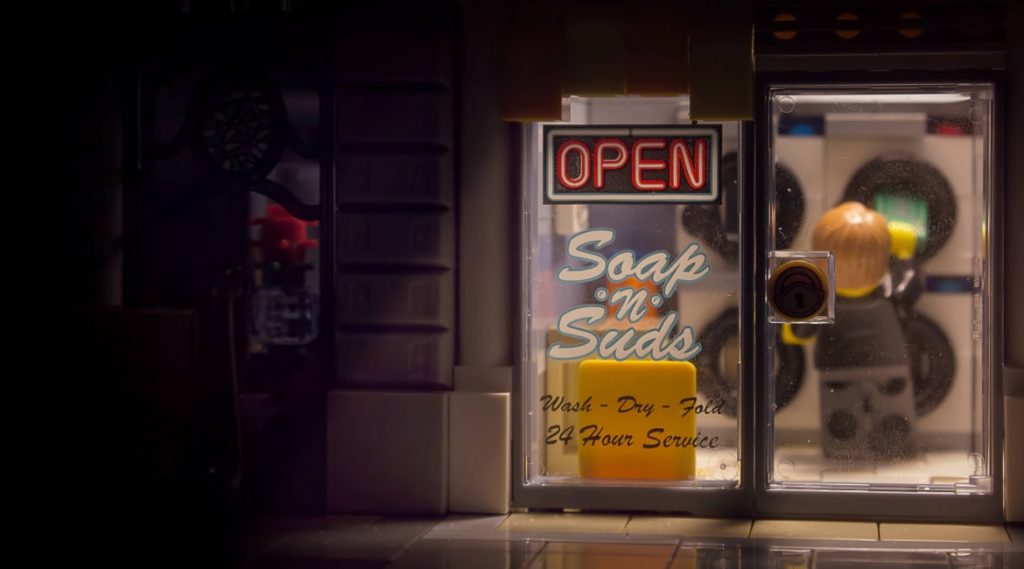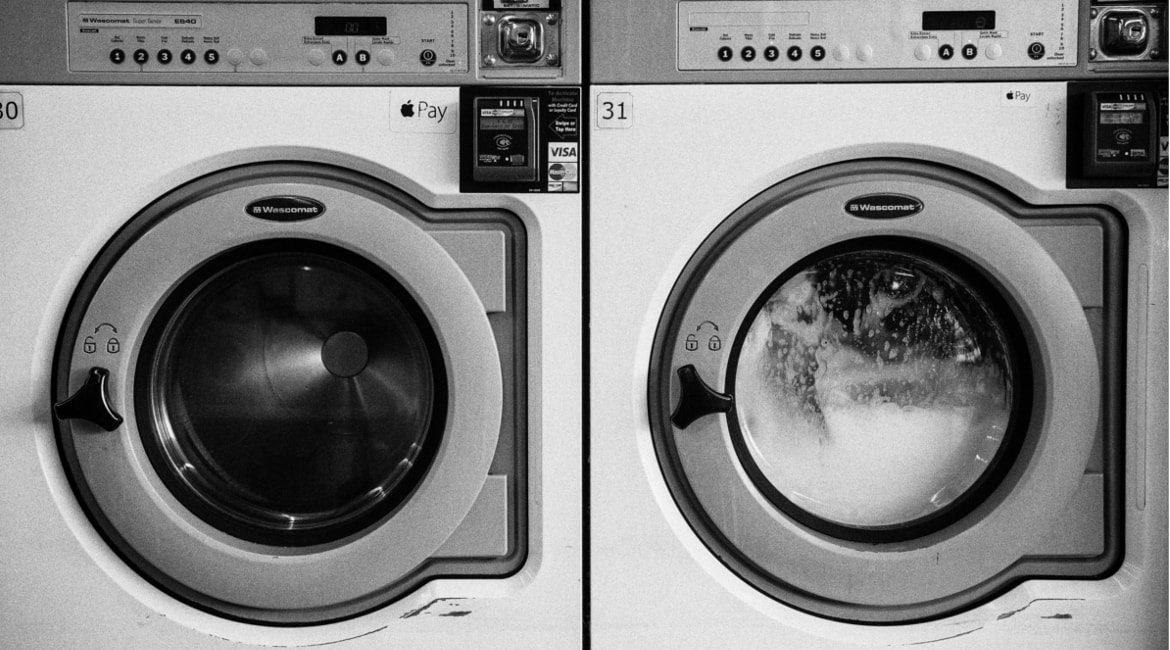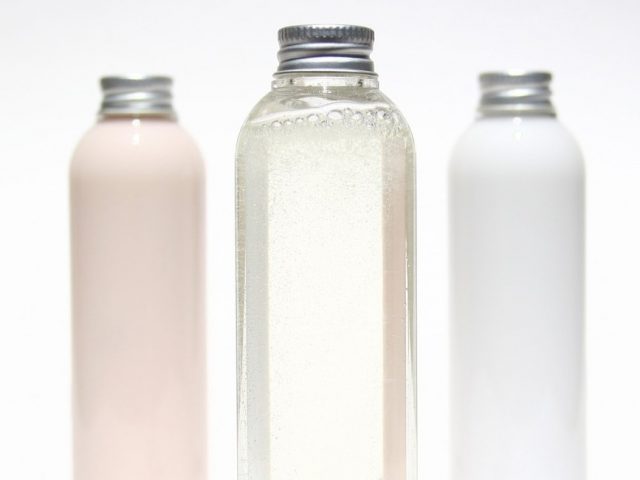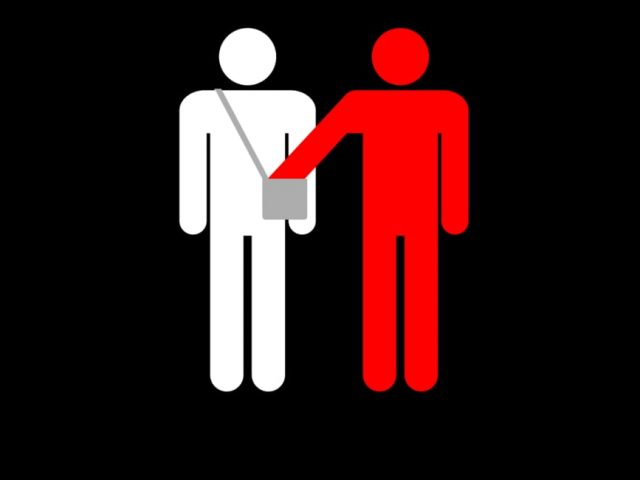Stale Sweat, Fermented Diapers, Sour Milk, and Fabric Softener.
Ah, yes, the good old laundromat. When I was young it seemed there was one in every a strip mall – next to a pizza parlour or KwikKash. The laundromat was an essential part of many neighborhoods, providing cleanliness, of course, but also acting as an important “social-centre”. In fact, social scientists have considered the laundromat an example of “anthropology in action”.
The laundromat of my youth was pretty unexciting, but at least it was comfortable. It usually had plastic chairs, vending machines and magazines; it was warm, humid and rather cozy. The machines – Maytags, mostly – would churn and spin away reassuringly all day. The place was terrifically bright, too, due to the intense fluorescent light – good for reading the lurid magazines.
The smell of the laundromat was also an interesting feature – stale sweat, fermented diapers, cigarette smoke, sour milk, dogs, cats, detergent, fabric softener, cheap perfume.
Someone could march you blindfolded into a laundromat and you’d know just where you were.
In keeping with the Scientific American idea, I assert that in my university days the laundromat was the cheapest way of scaling the social ladder. Making the leap from scruffy to preppy cost a mere 35 cents – a quarter for the washer and a dime for the dryer.
Cheap though it was, some of us cut the cost entirely by a trick involving Scotch Tape. We’d stick the tape to a coin, insert it— and the machine would start up . The coin was then deftly retrieved for future reinvestment. The Latin scholars among us called this practice laundrus interruptus. It’s also your basic money-laundering. I’m appalled when I think of it.
But my favorite laundromat experience happened on a motorcycle tour of Appalachia in 1968. My buddy Bruce and I rode a 305cc Honda Dream – underpowered and overloaded – all the way from Montreal. It rained every day for two weeks, and we were road-weary, damp and cranky. However, things began to look up when we rode into the tiny town of Mocksville, North Carolina.

As luck would have it, on Main Street we spied a shabby laundromat. We looked at one another, smiled, and nodded. It was just the place to dry off and warm up. The key thing about this place is that it had a “Restroom”. Strangely enough, this was to be the means of our deliverance.
Well, we spent the next hour running between the restroom and the dryer in various stages of undress, juggling dimes and clothes, until in the end, both of us were warm, dry and feeling quite restored – and much more respectable than when we rode into town. We were so happy we sprung for a room at the Mocksville Hotel for the night – for the princely sum of $2.50. Those were the days.
A bit of laundromat history may interest you. The electric washing machine came on the scene in the 1920s; it was a source of considerable liberation for “the lady of the house”, and quickly gained popularity. However, during the Depression, many families couldn’t afford one; thus, the idea of shared rental machines emerged. In 1934 John Cantrell of Fort Worth, Texas opened the first laundromat in the world. He called it a “Washeteria” – and that’s what they’ve called laundromats in Texas ever since.
The popularity of laundromats peaked in the ’90s. But nowadays, we find the old-style laundromat is in trouble. Urban redevelopment and gentrification are squeezing laundromats out of their old neighborhoods. Rising living standards have meant that most people now own their own machines. Moreover, the water and energy costs of a laundromat are considerable. Accordingly, many laundromats are going the way of the dodo, the floppy disc and the phone book.
A case in point is Lavanderia on Mission Street in San Francisco. It’s been called an “urban relic”; it’s been there for over a quarter-century. It’s peeling and crumbling, and the machines are just about beat. On their website, one customer commented,
Half the washers are broken… the floor here is also disgusting.
Lavanderia is owned by San Francisco’s laundromat kingpin, Robert Tillman. He’s in a bit of a bind these days. The place doesn’t pay well anymore, and he wants to demolish it in order to make better use of the land. Trouble is – the City has ruled Lavanderia an “essential service and social hub”, and has forbidden demolition. Tillman recalls, likely with a catch in his voice, “The ’90s were a great time for the laundry business.”
So what does the future hold for the laundromat? Will it indeed go extinct, or will there be adaptations allowing it to survive – even thrive? I’m betting on survival – because of some wonderfully creative things appearing on the laundromat scene. Plus, of course, there’ll always be plenty of dirty clothes.
We’re now seeing the appearance of the “boutique laundromat” – a strange juxtaposition if I ever heard one. These are laundromats with certain enhancements – one might say enticements – to separate customers from their money, while ensuring their own viability. I’ve surveyed the world laundromat landscape and have spotted some notable successes in this regard – especially in the U.S., Italy and France.

The smartest reinvention of the laundromat I know is Brain Wash – 1122 Folsom Street, San Francisco. There’s plenty going on there. Says entrepreuse and founder Susan Schindler, “You can wash and fold laundry, sip beer and catch comedy or spoken-word acts at this multitasking venue.”
And that’s not all; the place is bright and attractive, and claims a “laid-back vibe” – it’s San Francisco, after all. Art adorns the walls; there’s a fine menu, including what they call “killer soups”. And as if that weren’t enough, you can also get Brain Wash ball caps, laundry bags and T-shirts. Now that’s thinking!
If Mr.Tilman of Lavanderia and his Luddite colleagues are to avoid oblivion, they’ll have to adopt some of the ideas of Brain Wash – which, incidentally, is only a mile away.
And that’s all I have to say for the moment on this grand theme. Now, may I suggest you check out guitarist Albert King’s marvelous version of Laundromat Blues? It’s fun – and will add another dimension to your appreciation of the subject.
Cheers!






Facebook Comments